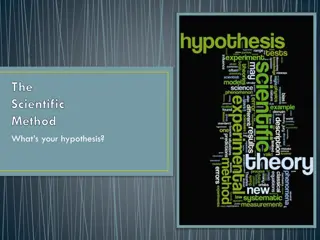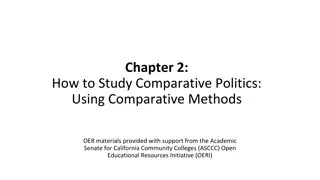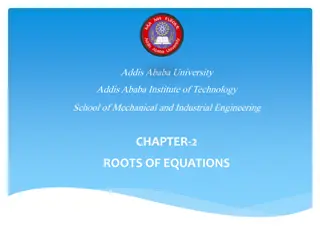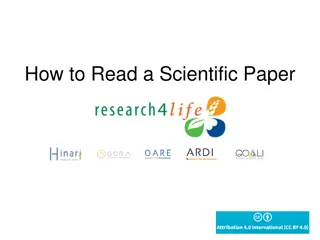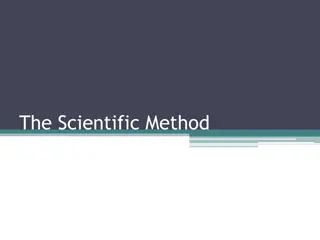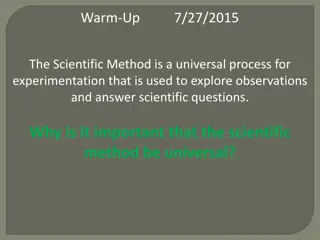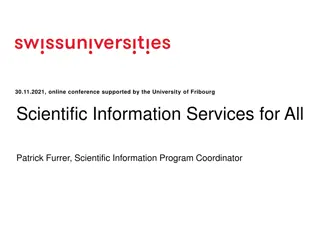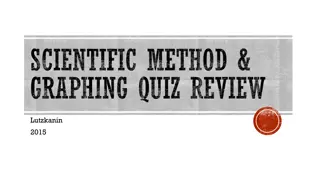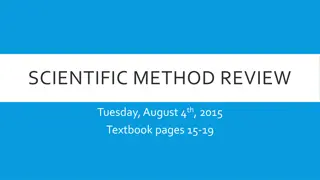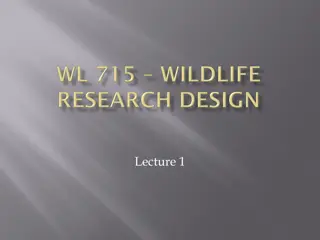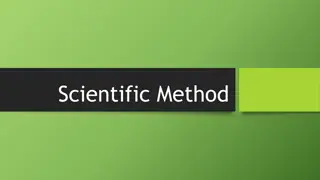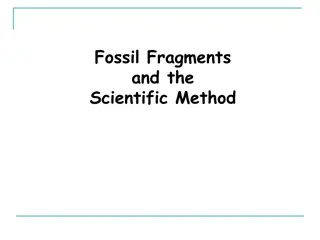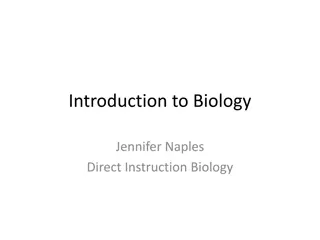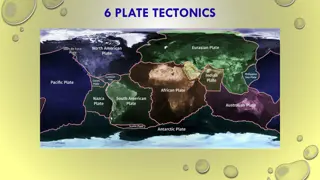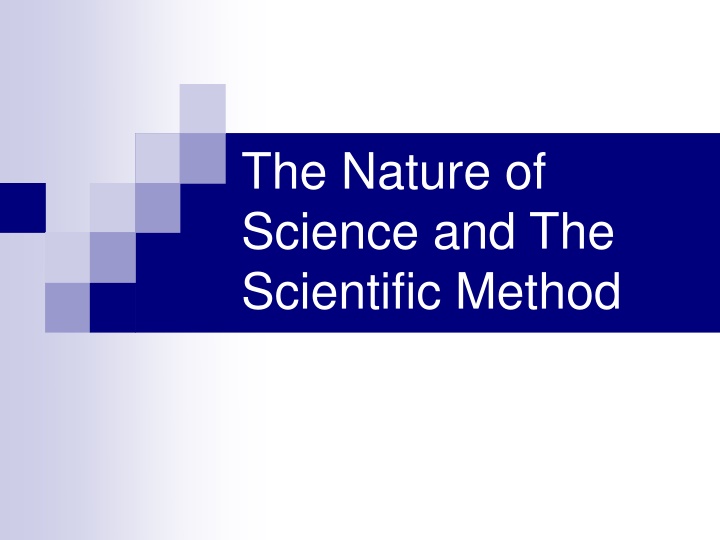
The Scientific Method: Steps and Importance
Explore the essence of science and the scientific method, uncovering the 6 vital steps from asking questions to communicating results. Delve into critical thinking, the nature of science, and the significance of observations leading to hypotheses. Discover the organized approach scientists use to tackle questions and solve problems, emphasizing the importance of data analysis and unbiased reasoning in the process.
Download Presentation

Please find below an Image/Link to download the presentation.
The content on the website is provided AS IS for your information and personal use only. It may not be sold, licensed, or shared on other websites without obtaining consent from the author. If you encounter any issues during the download, it is possible that the publisher has removed the file from their server.
You are allowed to download the files provided on this website for personal or commercial use, subject to the condition that they are used lawfully. All files are the property of their respective owners.
The content on the website is provided AS IS for your information and personal use only. It may not be sold, licensed, or shared on other websites without obtaining consent from the author.
E N D
Presentation Transcript
The Nature of Science and The Scientific Method
Learning Objectives I can state the 6 steps to the scientific method. I can explain the 6 steps to the scientific method.
Overview What is Science? The Scientific Method From Hypothesis to Theory
Critical Thinking Using data and facts to make inferences, draw conclusions, solve problems, etc. Should be unbiased thought but rarely is
What is Science SCIENCE IS .. a way in which answers related to NATURAL events are proposed a way in which people can learn and UNDERSTAND events in the NATURAL WORLD. based on OBSERVABLE EVENTS a study of the NATURAL WORLD a method of DISCOVERY and UNDERSTANDING by using a PROBLEM SOLVING process called the????
Scientific Method Scientific Method - A series of steps scientists use to answer questions and solve problems. An organized plan for gathering, organizing, and communicating information.
6 Steps to the Scientific Method 1. Ask a Question 2. Form a hypothesis 3. Test the hypothesis 4. Analyze the Data. Collect, Organize and 5. Draw Conclusions 6. Communicate the results
Step 1: Ask a Question Ask a question from our observations Observation Use of the senses to gather information. Sight, Smell, Touch etc. Observations of natural events usually raise a question Why did the water rise when the candle went out? Research is usually done to help find out more about the question raised
The Observation starts it all An observation is a visible or provable fact or occurrence VS. An inference is, the act of reasoning from factual knowledge or evidence. This is your opinion drawn on the observations you have made.
Step 2: Form A Hypothesis Based on your observation a Hypothesis is formed that tries to explain your observation or answer your question A hypothesis tries to predict or determine the outcome of your experiment even before the experiment is done Predictions usually stated in an if .. Then statement. Ex: If I drop a rock then it will fall down toward the ground HYPOTHESIS MUST BE TESTABLE!
Step 2: Form a Hypothesis Example Based on an experiment designed to test a hypothesis If/then statements hypothesis example: If the hypothesis is true, then the results of the experiment will be e.g. If exposure to fertilizer increases reproduction of bean plants, then the number of pods per plant should increase in plants exposed to fertilizer compared with control plants.
Step 3: Test the Hypothesis Controlled Experiments are used to test a hypothesis A controlled experiment is an experiment that tests only one factor at a time by only I.V. changed. a control group is compared with an experimental group. Variables are not changed in the Control Group. Control groups allows you to see if a change in a variable creates an observed outcome by comparing the control group with the exp group A variable is a factor that changes in a controlled experiment. Variables are changed in the Exp Group AND SERVE AS THE FACTOR TESTED
VARIABLES Independent Variable (I.V.) The variable being changed in the experiment Always in the X axis. Dependent Variable (D.V.) The variable that responds to the changed independent variable The variable being measured Always on the Y axis. EX: growing plants with different amounts of fertilizer
Variable Examples The relationship between drug dosage & frequency / intensity of symptoms Independent: amount of drug administered (dosage) Dependent: Frequency / intensity of symptoms The relationship between plant growth rate & duration of light exposure Independent: Amount of time of exposure to light Dependent: Plant growth rate
Constants and Controls A constant is a variable that does not change through the entire experiment a value that remains the same. VS. The CONTROL is the group or condition that is used as the basis for comparison for the results of the changes in the independent variable
Step 3 Continued Scientists try to design experiments that will clearly show whether a particular VARIABLE caused an observed outcome IF IT CANNOT BE OBSERVED THEN IT CANNOT BE TESTED!!! Can we test if a comet impact killed the dinosaurs? Why or Why Not? Sometimes models are used to represent a real object Used when it is difficult to control all of the variables or not possible to test the real thing
Variables are not Changed in C.G. One Variable Changed in Each Exp. Group
Step 4: Collect, Organize & Analyze Data Data collected from experiments Data is defined as: recorded observations or measurements (qualitative = description, quantitative = number data) Based on observations Utilize tools or senses: sight, smell, temperature change etc. Data is organized in tables, charts and graphs so that it can be more easily analyzed
Step 4: 2 Types of data Quantitative data - are numbers and are obtained by counting or measuring. Qualitative data - descriptions and involve characteristics that cannot be counted.
Example: In order to test the effectiveness of a new vaccine, 50 volunteers are selected and divided into two groups. One group will be the control group and the other will be the experimental group. Both groups are given a pill to take that is identical in size, shape, color and texture. Even though the volunteers are given identical looking pills, the control group will not actually receive the vaccine. Describe the control group. Describe the experimental group. This group will receive the vaccine. What variables are kept constant? The size, shape, color, and texture of the pill. What variable is being changed? Whether or not the pill contains the vaccine.
Step 5: Draw Conclusions Scientists decide whether the results of the experiment support a hypothesis. When the hypothesis is not supported by the tests the scientist must find another explanation for what they have observed NO EXPERIMENT IS A FAILURE: All experiments are observations of real events
Step 6: Communicate the Results Results must be communicated in the form of a written paper or presentation Communication helps other scientists performing the same experiments to see if the results of your experiment are the same as their results Helps people see if results are repeatable!
Theories Theories are explanations for some phenomena based on observation, experimentation, and reasoning. BASED ON MANY EXPERIMENTS Experiments that explain a theory MUST be repeatable You must be able to predict from a theory
LAWS Laws are summaries of many experimental results and observations Laws are not the same as theories because laws tell only what happens, not why it happens.
Technology Technology: An application of science to meet the needs of society engineers, inventors and creative people apply scientific knowledge to build new things or tools new technology can lead to new scientific discoveries ex: we could not learn about cells before the invention of the microscope Question: How does science lead to new technology and how does technology add to our scientific understanding of the natural world?




